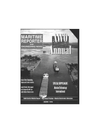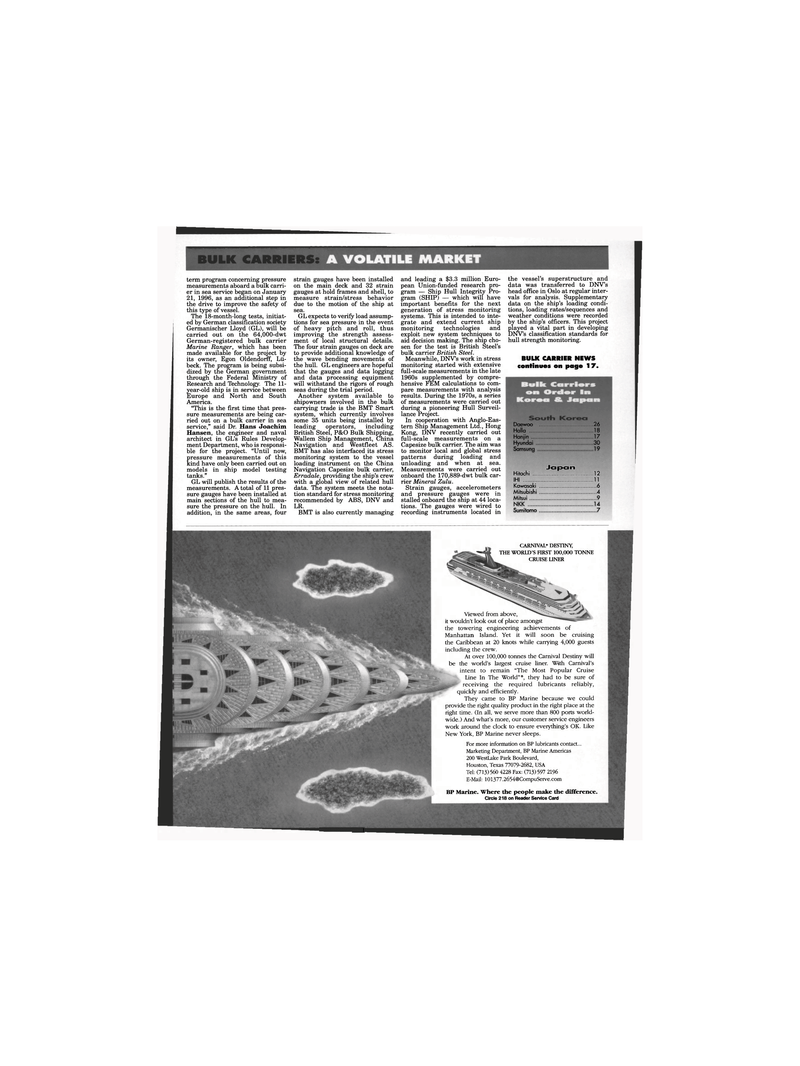
Page 11: of Maritime Reporter Magazine (March 1996)
Read this page in Pdf, Flash or Html5 edition of March 1996 Maritime Reporter Magazine
term program concerning pressure measurements aboard a bulk carri- er in sea service began on January 21, 1996, as an additional step in the drive to improve the safety of this type of vessel.
The 18-month-long tests, initiat- ed by German classification society
Germanischer Lloyd (GL), will be carried out on the 64,000-dwt
German-registered bulk carrier
Marine Ranger, which has been made available for the project by its owner, Egon Oldendorff, Lii- beck. The program is being subsi- dized by the German government through the Federal Ministry of
Research and Technology. The 11- year-old ship is in service between
Europe and North and South
America. "This is the first time that pres- sure measurements are being car- ried out on a bulk carrier in sea service," said Dr. Hans Joachim
Hansen, the engineer and naval architect in GL's Rules Develop- ment Department, who is responsi- ble for the project. "Until now, pressure measurements of this kind have only been carried out on models in ship model testing tanks."
GL will publish the results of the measurements. A total of 11 pres- sure gauges have been installed at main sections of the hull to mea- sure the pressure on the hull. In addition, in the same areas, four strain gauges have been installed on the main deck and 32 strain gauges at hold frames and shell, to measure strain/stress behavior due to the motion of the ship at sea.
GL expects to verify load assump- tions for sea pressure in the event of heavy pitch and roll, thus improving the strength assess- ment of local structural details.
The four strain gauges on deck are to provide additional knowledge of the wave bending movements of the hull. GL engineers are hopeful that the gauges and data logging and data processing equipment will withstand the rigors of rough seas during the trial period.
Another system available to shipowners involved in the bulk carrying trade is the BMT Smart system, which currently involves some 35 units being installed by leading operators, including
British Steel, P&O Bulk Shipping,
Wallem Ship Management, China
Navigation and Westfleet AS.
BMT has also interfaced its stress monitoring system to the vessel loading instrument on the China
Navigation Capesize bulk carrier,
Erradale, providing the ship's crew with a global view of related hull data. The system meets the nota- tion standard for stress monitoring recommended by ABS, DNV and
LR.
BMT is also currently managing and leading a $3.3 million Euro- pean Union-funded research pro- gram — Ship Hull Integrity Pro- gram (SHIP) — which will have important benefits for the next generation of stress monitoring systems. This is intended to inte- grate and extend current ship monitoring technologies and exploit new system techniques to aid decision making. The ship cho- sen for the test is British Steel's bulk carrier British Steel.
Meanwhile, DNVs work in stress monitoring started with extensive full-scale measurements in the late 1960s supplemented by compre- hensive FEM calculations to com- pare measurements with analysis results. During the 1970s, a series of measurements were carried out during a pioneering Hull Surveil- lance Project.
In cooperation with Anglo-Eas- tern Ship Management Ltd., Hong
Kong, DNV recently carried out full-scale measurements on a
Capesize bulk carrier. The aim was to monitor local and global stress patterns during loading and unloading and when at sea.
Measurements were carried out onboard the 170,889-dwt bulk car- rier Mineral Zulu.
Strain gauges, accelerometers and pressure gauges were in stalled onboard the ship at 44 loca- tions. The gauges were wired to recording instruments located in the vessel's superstructure and data was transferred to DNV's head office in Oslo at regular inter- vals for analysis. Supplementary data on the ship's loading condi- tions, loading rates/sequences and weather conditions were recorded by the ship's officers. This project played a vital part in developing
DNV's classification standards for hull strength monitoring.
BULK CARRIER NEWS continues on page 1 7.
Daewoo 26
Halla 18
Hanjin 7
Hyundai 30
Samsung 19
Japan
Hitachi 12
IHI 1
Kawasaki 6
Mitsubishi 4
Mitsui 9
NKK 14
Sumitomo 7
Viewed from above, it wouldn't look out of place amongst the towering engineering achievements of
Manhattan Island. Yet it will soon be cruising the Caribbean at 20 knots while carrying 4,000 guests including the crew.
At over 100,000 tonnes the Carnival Destiny will be the world's largest cruise liner. With Carnival's intent to remain "The Most Popular Cruise
Line In The World"®, they had to be sure of (P* receiving the required lubricants reliably, quickly and efficiently.
They came to BP Marine because we could provide the right quality product in the right place at the right time. (In all, we serve more than 800 ports world- wide.) And what's more, our customer service engineers work around the clock to ensure everything's OK. Like
New York, BP Marine never sleeps.
For more information on BP lubricants contact...
Marketing Department, BP Marine Americas 200 WestLake Park Boulevard,
Houston, Texas 77079-2682, USA
Tel: (713)560 4228 Fax: (713)597 2196
E-Mail: [email protected]
BP Marine. Where the people make the difference.
Circle 218 on Reader Service Card ___
CARNIVAL® DESTINY,
THE WORLD'S FIRST 100,000 TONNE
CRUISE LINER

 10
10

 12
12
